Symbols of the University | The Cornell Public Library | Cornell’s Twelve Presidents | | Andrew Dickson White, President, 1866-1885 | | Charles Kendall Adams, President, 1885-1892 | | Jacob Gould Schurman, President, 1892-1920 | | Livingston Farrand, President, 1921-1937 | | Edmund Ezra Day, President, 1937-1949 | | Deane Waldo Malott, President, 1951-1963 | | James Alfred Perkins, President, 1963-1969 | | Dale Raymond Corson, President, 1969-1977 | | Frank Howard Trevor Rhodes, President, 1977-1995 | | Hunter Ripley Rawlings III, President, 1995-2003 | | Jeffrey Sean Lehman, 2003-2005 | | David J. Skorton, 2006 | Inaugurating the Presidents |
| Cornell’s Twelve Presidents Jacob Gould Schurman, President, 1892-1920 Jacob Gould Schurmanís administration was characterized by the dramatic growth of the Universityís facilities, and its shift from a privately endowed institution to one supported by a combination of state and private funding. A College of Veterinary Medicine was established with full state support, but under Cornellís control. Extension work began in New York in 1894. In 1904, a state appropriation established the New York State College of Agriculture at Cornell. The Cornell Medical College began in 1898, and a new building was constructed in New York City.
In 1914, the Drill Hall (Barton Hall) was constructed with state funding. When the United States entered World War I, the U.S. War Department organized a Studentsí Army Training Corps and contracted with the University to provide academic and military training. In 1918, nearly half of the student population was enrolled in the S.A.T.C.
Schurmanís administration also saw the transformation of the American university from a teaching institution to a research establishment in which teaching is done. Several major academic journals were initiated at Cornell during this period. Schurman also strongly supported diversity in the student body, including the provision of scholarships for Chinese students. Regarding an African-American woman living in Sage College, he wrote in 1911: ďAll university doors must remain open to all students irrespective of color or creed or social standing or pecuniary condition.Ē Throughout the twenty-eight years of his presidency, Schurman was a proponent of academic freedom and an advocate of a liberal intellectual atmosphere on campus. In Schurmanís time, Cornell became one of the great universities of America. Enrollment increased from 1,538 to 5,765, the physical domain from 200 to 1,465 acres.
Jacob Gould Schurman was born in 1854 in Freetown, Prince Edward Island. He attended the Prince of Wales College and Acadia College in Nova Scotia, and graduated in 1877 from the University of London with first class honors in mental and moral science. He then studied philosophy for a year at Edinburgh and London, earning an M.A. and D.Sc. in 1878. He also studied philosophy in Berlin, at Gottingen, and at Heidelberg. In 1880, Schurman returned to North America to teach English at Acadia College and then at Dalhousie University. In 1886, he came to Cornell University as professor of Christian ethics and moral philosophy, and, in 1890, was named to head the Susan Linn Sage School of Philosophy at Cornell. Two years later, he became Cornellís third president.
While still president of Cornell, Schurman served as chairman of the First Philippine Commission in 1899. In 1912 and 1913, during the Balkan Wars, he was minister to Greece and Montenegro. Upon retiring from Cornell, he served as Minister to China from 1921 to 1925 and as Ambassador to Germany from 1925 to 1930, where he was particularly popular for his efforts to rebuild the University of Heidelberg. After returning to the U.S., he lectured in China and wrote on international subjects. Jacob Gould Schurman died in 1942. << Prev | Next >> | 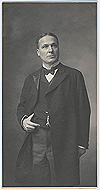 + +
Jacob Gould Schurman, ca. 1915.
Jacob Gould Schurman, ca. 1915. Platinum print photograph.

 + +
1916 Cornell University Faculty
In 1911 two professorships were established for Martha Van Rensselaer and Flora Rose - the first full professorships granted to women at Cornell. This photograph shows Annette Warner, Flora Rose, and Blanche Hazard, all professors in home economics.

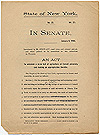 + +
The New York State College of Agriculture
In January, 1904, an act before the New York State Senate established a College of Agriculture at Cornell.

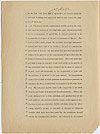 + +
The New York State College of Agriculture

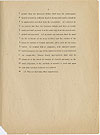 + +
The New York State College of Agriculture

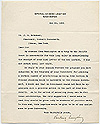 + +
Letter from the Imperial Chinese Legation to Jacob Gould Schurman, May 30, 1906.
The number of Chinese students at Cornell was expanded in 1906 when the Trustees voted at their meeting of June 20, 1906 to establish six undergraduate scholarships a year for the benefit of Chinese students. President Theodore Roosevelt later agreed to remit the indemnity charged against China for the Boxer Rebellion in 1900 and to use the funds for the scholarships. 
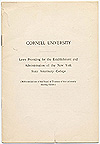 + +
The College of Veterinary Medicine
J. G. Schurman helped establish a State College of Veterinary Medicine, but managed to keep it under Cornellís control. 
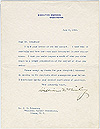 + +
Letter from President William McKinley to Jacob Gould Schurman.
Letter from William McKinley, June 4, 1900.
Jacob Gould Schurman became a presence in the national and New York State Republican parties, and it was thought that only his Canadian birth prevented him from seriously pursuing the Presidency of the United States. 
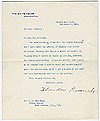 + +
Letter from President Theodore Roosevelt to J. G. Schurman
Letter from Theodore Roosevelt on White House stationery, sent from Oyster Bay, New York. September 1, 1906.

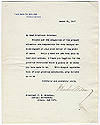 + +
Letter from President Woodrow Wilson to J. G. Schurman
Letter from Woodrow Wilson sent to Schurman from the White House on March 21, 1917. 
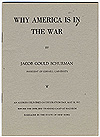 + +
Why America is in the War
Why America is in the War, an address given by Schurman on Decoration Day, May 30, 1917. Cornell supplied more Army officers to World War I than any other commissioning source including West Point. 
|
